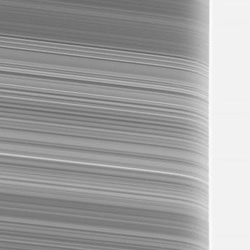
Saturn’s atmosphere makes the rings look like they’re bending just as they pass behind the planet. Image credit: NASA/JPL/SSI. Click to enlarge.
Saturn’s rings appear strangely warped in this view of the rings seen through the upper Saturn atmosphere.
The atmosphere acts like a lens in refracting (bending) the light reflected from the rings. As the rings pass behind the overexposed limb (edge) of Saturn as seen from Cassini, the ring structure appears to curve downward due to the bending of the light as it passes through the upper atmosphere.
This image was obtained using a near-infrared filter. The filter samples a wavelength where methane gas does not absorb light, thus making the far-off rings visible through the upper atmosphere.
By comparing this image to similar ones taken using filters where methane gas does absorb, scientists can estimate the vertical profile of haze and the abundance of methane in Saturn’s high atmosphere.
The image was taken in visible light with the Cassini spacecraft narrow-angle camera on April 14, 2005, through a filter sensitive to wavelengths of infrared light centered at 938 nanometers and at a distance of approximately 197,000 kilometers (123,000 miles) from Saturn. The image scale is 820 meters (2,680 feet) per pixel.
The Cassini-Huygens mission is a cooperative project of NASA, the European Space Agency and the Italian Space Agency. The Jet Propulsion Laboratory, a division of the California Institute of Technology in Pasadena, manages the mission for NASA’s Science Mission Directorate, Washington, D.C. The Cassini orbiter and its two onboard cameras were designed, developed and assembled at JPL. The imaging team is based at the Space Science Institute, Boulder, Colo.
For more information about the Cassini-Huygens mission visit http://saturn.jpl.nasa.gov . For additional images visit the Cassini imaging team homepage http://ciclops.org .
Original Source: NASA/JPL/SSI News Release
